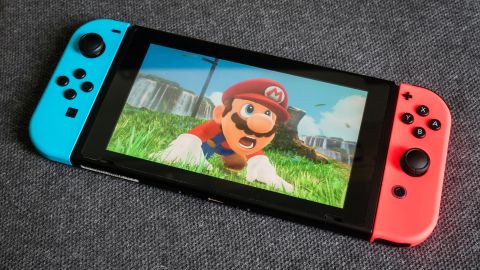Why you can trust TechRadar
This original review was based on the Nintendo Switch model released at launch. However Nintendo has since updated its standard model to one which boasts a longer battery life.
With the Nintendo Switch having to work as a handheld as well as a home console, we were initially worried that the console's graphical abilities would be limited. Internally the Switch is using an Nvidia Tegra X1 chip, which is broadly similar to what was found in the Nvidia Shield.
That's not exactly a bad thing considering the Shield is a 4K-capable set-top box, but you have to remember that as a portable device the Switch needs to make compromises to ensure decent battery life. At launch, concerns over graphical horsepower appeared to be partly borne out, but we wouldn't call them deal-breakers.
Nintendo Switch: graphical performance

- Roughly equivalent to Wii U
- Not on a PS4 or Xbox One level
- Strength of Nintendo's art direction makes up for technical shortcomings
The Legend of Zelda: Breath of the Wild, for example, runs at a resolution of 720p on the Wii U, while this is boosted to 900p on the Switch when docked and outputting to a Full HD screen (4K output isn't supported).
On the surface this suggests the Switch has the graphical edge on the Wii U, but we experienced frequent frame rate drops when playing the game on our television. Meanwhile, when played on the Switch's own 720p screen, the game maintained a consistent frame rate.
These observations would suggest that we're looking at a new console with roughly equivalent power to Nintendo’s last-generation system, but we'll see how the situation improves as developers continue to get to grips with the new hardware.
Nintendo has never been one to push the graphical envelope though, not really. Past games such as the Wii U's Mario Kart 8 have certainly looked good, but this has been more as a result of their distinctive art style than the technical prowess of their graphics. We're thankful then that this has tended to be a strong suit of Nintendo's in the past.
The look of the games (in handheld mode at least) is also helped by the quality of the Switch's screen. Although it's only a 720p resolution, the screen is bright and its colors are vibrant. It's not up there with the best smartphones on the market, but it's definitely a step above Nintendo’s past handhelds.
We'll have to see what the Nintendo Switch achieves in the graphical department going forward, but this certainly isn't a console to rival the likes of the PlayStation 4 or Xbox One. Since the release of Sony and Microsoft's new generation successors, the PS5 and Xbox Series X/S, that technological gap has only widened further.
Still, the games we've played look very good for handheld games, but as console games they don't quite have the same fidelity of current-generation games on other consoles.
Nintendo Switch: battery life

- As low as 2.5 hours for graphically intensive games
- Enough for a commute, but longer journeys might prove problematic
- Ability to charge over USB allows use of portable battery packs
Much has been made of the Switch's battery life, which Nintendo has claimed will last between 2.5 and 6 hours. In our experience this claim has rung true. When actively playing Zelda we got around 2.5 hours, which was enough to cover our commute to and from work in a single day before we charged the Switch overnight.
If you're looking to use the console for a longer period, such as on a flight, then there are a couple of things you can do to squeeze some more battery life out of the console – turning on airplane mode for example (although this prevents you from detaching the Joy-Cons), and dimming the screen.
Additionally you're able to use portable battery packs, but this is hardly ideal, and we found that the Nintendo Switch draws so much power that at best they prevented the battery from dropping during play, rather than actively recharging it.
It's difficult to compare this battery life to previous handheld consoles, as even on the Switch itself this battery life will vary massively between different games, but we've seen a rest-mode comparison that put the Switch ahead of the Vita and PSP, while losing out to the DS and GameBoy Advance.
The bottom line is that this is a console that should be able to deal with your daily commute, but might struggle with longer journeys.
Jon Porter is the ex-Home Technology Writer for TechRadar. He has also previously written for Practical Photoshop, Trusted Reviews, Inside Higher Ed, Al Bawaba, Gizmodo UK, Genetic Literacy Project, Via Satellite, Real Homes and Plant Services Magazine, and you can now find him writing for The Verge.
- Henry Stockdale
- Rhys WoodHardware Editor
- Kara PhillipsEvergreen Writer


